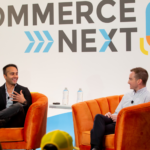This past year has been a whirlwind of adjusting to different economic conditions and changing marketing strategies in a post-pandemic world. At our CommerceNext 2022 conference, top retailers and brands shared the strategies that they developed to conquer the challenges that 2022 brought. Read on for the rundown on the emerging ecommerce trends of 2022 from Jenni Kayne, GoPuff and Qurate Retail Group.
1. Scaling Content for Social Media
Content is the atomic unit, according to Emily Hickey, who runs Chief Detective and produces advertising for Jenni Kayne. At our 2022 summit, she and Alexia Ritacco, CMO of Jenni Kayne, explained how their foundation for growing from an $8 to $100 million company was focusing on content.
Jenni Kayne runs a four pillar system of content marketing. Half of their advertising efforts take form in studio and offsite shoots, while the other half is completely dedicated to both team and influencer UCG. Hiring members of your own team may be a great strategy for your brand to expand through people who truly embrace and know it. But how can you make sure each piece of content you produce will be a success?
Small-scale testing is the best way to foolproof posting the best content. Jenni Kayne gave an example of testing by comparing photos of their product with a white screen in the background compared to a screen with other aesthetically pleasing lifestyle items like a suede couch or patterned rug. The pictures with other lifestyle elements far outperformed the other. It is crucial to know what cues can set your imagery apart and attract the most people. Testing is a great way to do this, as it gives you access to top impressions and makes creative flywheel efficient.
Another thing to keep in mind is optimizing for social media algorithms. Brands should aim for the algorithm to promote their products to those who are most likely to buy when seeing an adt online. Pro Tip: perform small-scale testing on every single marketing or advertising tactic. If not, the algorithm could penalize your brand for a failed ad and hurt your chances of reaching the audience most willing to buy your product. In 2023, it will be crucial to prioritize producing good content through testing for the algorithm.
2. Consumer Instant Needs
Now more than ever, it is important to know that the market economy could drastically change at any moment, resulting in changing customer needs. But, just like catering to an algorithm, brands can cater to different customer needs as well.
One example of adjusting to customer needs is GoPuff’s strategy in addressing consumer instant needs. GoPuff has radically changed since its inception as a college student delivery service. It started off with brick-and-mortar retail, but then had to shift its approach with the introduction of Amazon’s one-to-two day shipping. The brand has since aimed to be an instant needs service, as customers began expecting both fast and consistent delivery.
GoPuff adds categories of service according to customer needs. For example, during the pandemic, they were able to provide families with baby formula during major shortages and supply chain issues. Their leaders were able to anticipate changing market conditions and maintain supply of crucial items like formula. Ensure that your brand is doing research on economic trends to come to best prepare for different conditions.
Even with harsh economic conditions for GoPuff in 2022, it is still seeing success. While delivery fees have increased, GoPuff has doubled down on guaranteeing instant delivery to maintain their customer loyalty. In 2023, catering to your consumers needs, whether they are instant or not, is only going to be more expected from brands.
3. Live Shopping
If you’re not already familiar with live selling, Brian Beitler from Qurate says you are running out of time to hop on this trend! But don’t worry, it’s not too late yet. As everyone spends more and more time online (specifically members of Gen Z), people are relying on human interaction through online experiences. Virtual commerce, or vCommerce, allows this to be a possibility.
There are four types of vCommerce:
- Linear TV
- Social commerce
- Digital streaming commerce
- Video ecommerce
Video ecommerce has the most potential for growth right now. Brands are consistently looking to promote their products through video ecommerce measures like livestreaming. Qurate has shifted its brands like QVC into doing more livestreaming on social platforms to engage with younger audiences and offer a more personable experience. This kind of interaction with the consumer is the future of marketing and advertising, so be sure to experiment with live selling in 2023!
These emerging ecommerce trends were extremely significant for brands in 2022, and they will continue to be important to keep in mind in 2023. Want to learn more about the latest trends in the industry and best prepare for what 2023 has in store? Join us at CommerceNext’s 2023 conference, The Ecommerce Growth Show on June 20-21. You will be able to hear from 120+ of the industry’s leading speakers across 50+ informative sessions to learn about tips like the ones from this blog. Be sure to register now to secure your spot!
Related Posts
-
Recession Proof Marketing Strategies: Tips from the 2022 CommerceNext Ecommerce Conference
The looming recession and the overall current macroeconomic state of…
-
Customer Retention Strategies and Personalization
The holiday season is upon us which means companies will…
-
Join The CommerceNext Ecommerce Growth Show in June 2023
It’s time—registration for our Ecommerce Growth Show is open now! …
-
Mother’s Day Ecommerce Trends for 2021
With Mother’s Day in just a few weeks, you may…
-
New CommX Research Report: 2022 Digital Trends and Investment Priorities
For their premier research report of 2022, CommerceNext partnered with…
-
Ecommerce Conference Recap: Our Favorite Themes From CommerceNext 2022
We are thrilled to get the CommerceNext community back together…







